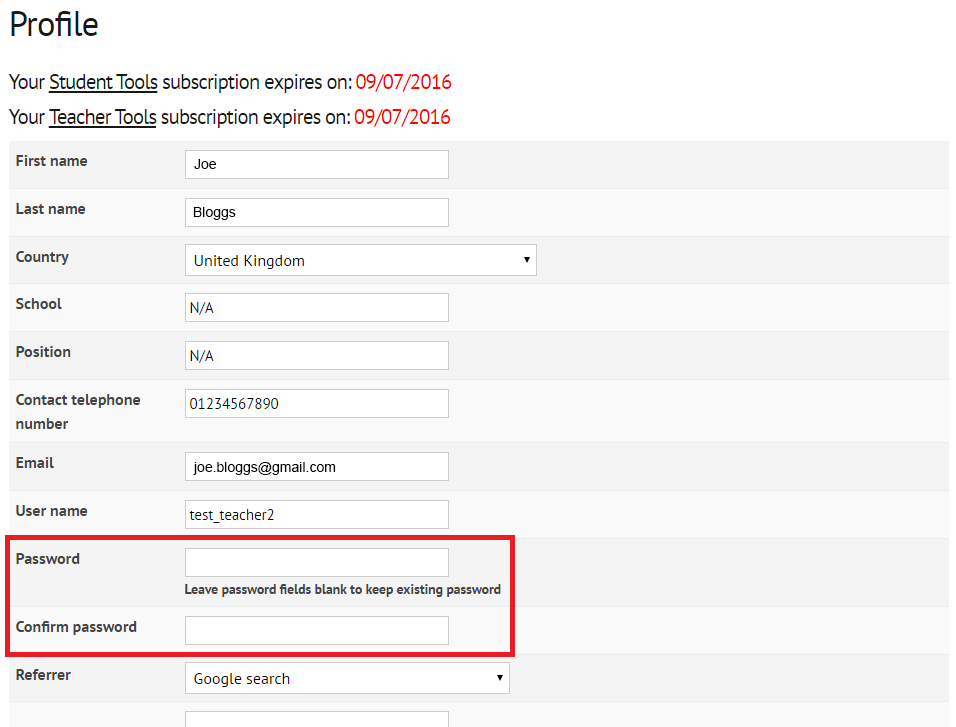We Care About Your Privacy
By clicking “Accept all”, you agree to the storing of cookies on your device to enhance site navigation, analyze site usage, and assist in our marketing efforts. View our Privacy Policy.
The Learning Village provides targeted online and offline learning for 6-11 year-olds ('The Village') and 11-16 year-olds ('The Islands') year-old English language learners in schools where English is the language of instruction.
It focuses on three strands of learning:
The Learning Village offers EAL blended learning for learners in schools (for induction to English, gap filling and pre-teaching vocabulary and language structures) both for independent learning and small group teaching. Suitable for learners of any language due to its image-based methodology, including those not literate in their home language.
The impact of the Learning Village was tested in the following schools:
Longer term research has commenced in Lea Forest Academy, Birmingham and Wood End Academy, London.
Testing showed significant results: https://www.learningvillage.net/reviews.
You can find a document containing several case studies and testimonials demonstrating the impact of the Learning Village by clicking here.
You can find a case study of the impact of the Learning Village in Tudor Primary in London, UK, by clicking here.
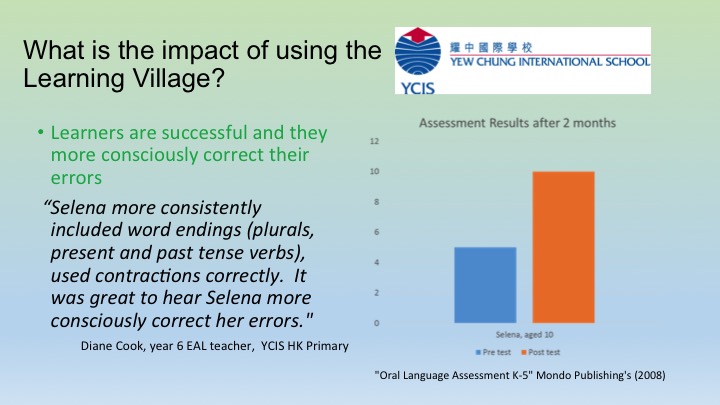
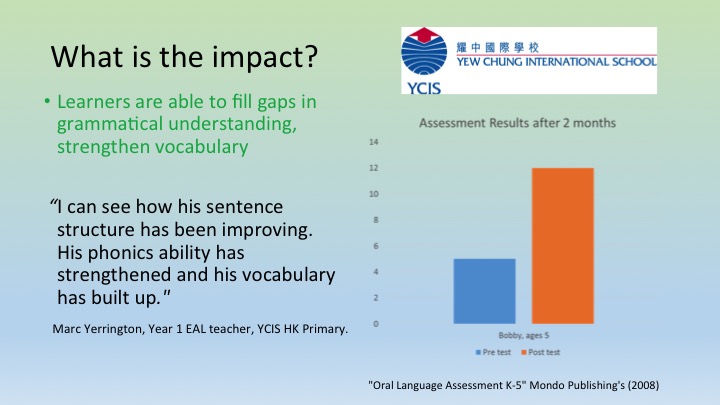
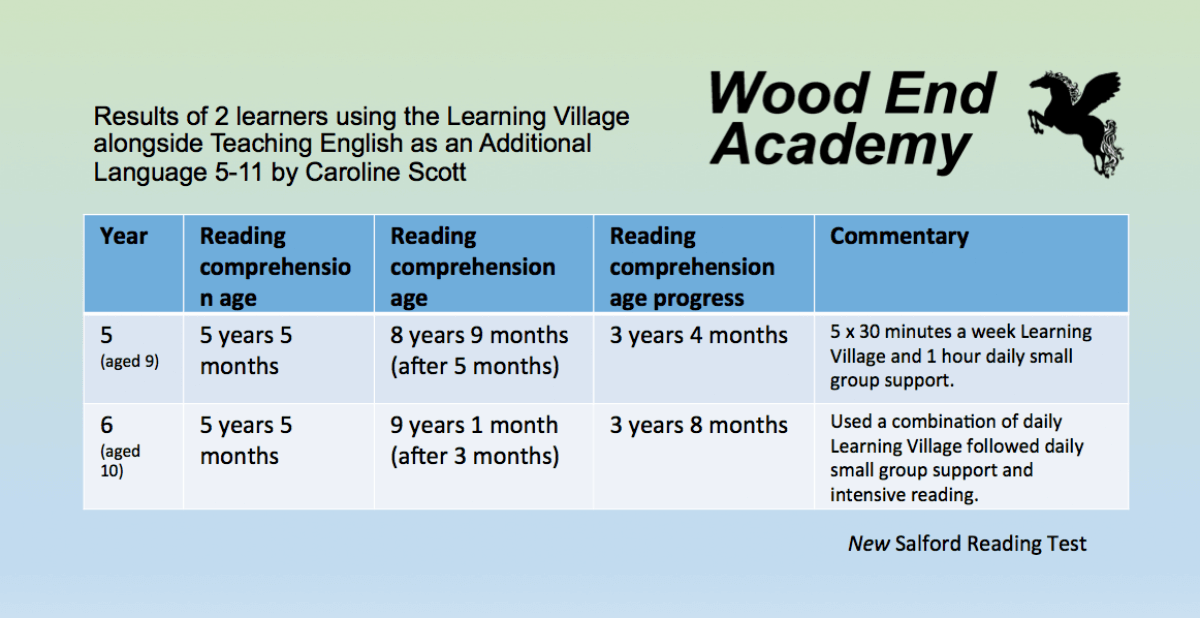
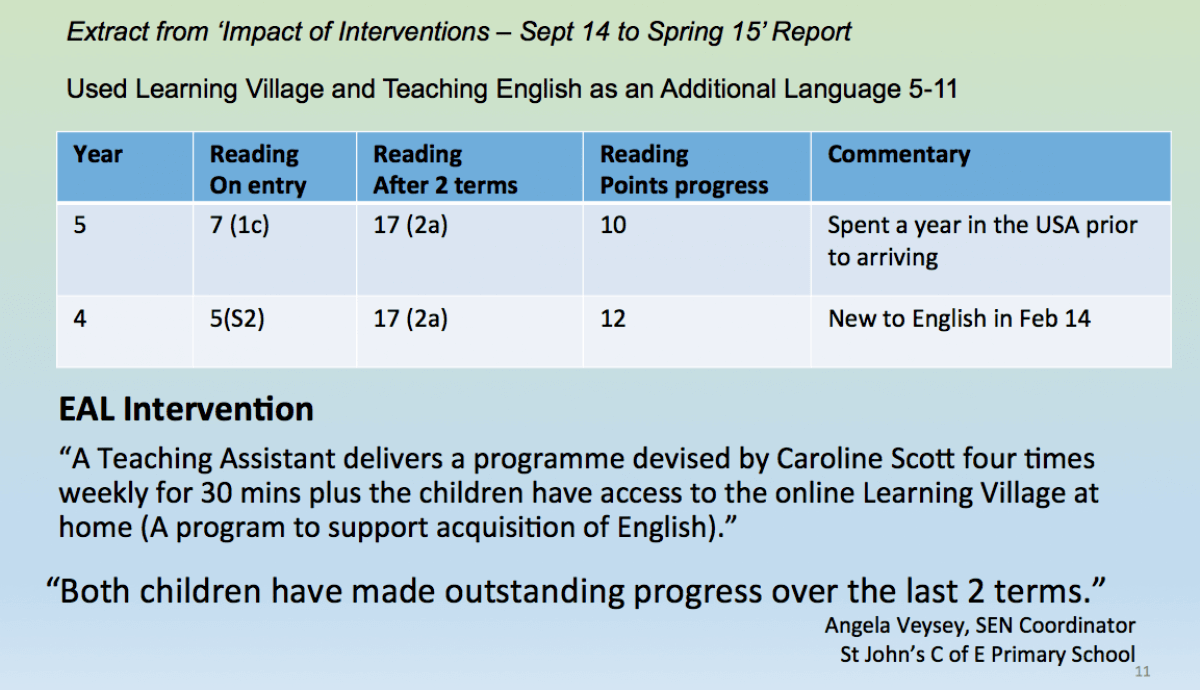
Download a PDF for student 'Ali' here (right-click then 'Save as').
The Learning Village is built for EAL 'from the ground up'. It's founded on our extensive experience of teaching EAL and on academic research into the best techniques for teaching and learning English across the curriculum. It's an immersive language learning programme, based on learning through images, rather than translation, with a substantial amount of home language support where appropriate. This means that it is suitable for learners of any language background, including pre-literate learners.
The programme follows a carefully developed methodology, with an interactive, collaborative cycle of learning. It has grown out of the publications by company director Caroline Scott:
These publications draw upon Caroline's wealth of practical experience in EAL. They are firmly grounded in research and theory, giving the Learning Village its knowledge-based foundation.
A form-focused approach
The Learning Village takes a 'form-focused' approach to EAL. This is a teaching method that concentrates on 'forms', such as particular grammar and language structures. In the Learning Village, pupils learn new vocabulary, which they then insert into meaningful language structures, often with a particular grammatical focus. The use of scaffolded flashcards and similar activities is an important part of our form-focused approach.
There is a great deal of evidence to support this method of learning. Paul Nation, for example, is one of the most influential scholars in the field of EAL. In various publications, he cites studies showing the effectiveness of learning through the strategic use of form-focused flashcards. He points out the importance of achieving a balance between meaning-focused activities and fluency development activities.
A form-focused approach must be combined with real-life experience of using English. The Learning Village is designed for use in English-medium classes and schools where English is the language of instruction. Our students are therefore subject to ‘immersion’ or bilingual learning in the language and experience a communicative approach alongside their form-focused learning activities.
A blended (hybrid) programme with small-group teaching
The Learning Village is a blended - or hybrid - EAL programme. The online programme of learning is supported by small-group teaching within the classroom. Students are able to work independently, as well as collaboratively in small groups. This works alongside using resources to differentiate in class.
Working in small groups allows learners to feel confident and more ready to take risks in language learning. This supports newcomers in feeling safe, settled and valued, and gives them a sense of belonging.
Research carried out by Asta Lileikienė and Lina Danilevičienė for the Baltic Journal of Sport and Health Sciences describes the uncomfortable feelings learners can experience when learning or using a new language. The authors show that this anxiety is a powerful predictor for demotivation in language learning and impedes the acquisition of a new language. The authors’ analysis also reveals that the majority of younger respondents demonstrate a higher degree of anxiety.
Pauline Gibbons, an author and expert in the field of EAL, notes in English Learners Academic Literacy and Thinking that: “Separate or some kind of ‘sheltered’ instruction may...be the best option for recently arrived English language learners.” This is why the Learning Village supports an induction process for new arrivals, as well as the pre-teaching of language before it is covered in lessons.
Using carefully selected starting points, much can be identified and covered in various ways prior to a lesson. Judy Lombardi, in Beyond Learning Styles: Brain-based Research and English Language Learners, highlights the use of "front-loading - pre-teaching, modeling and rehearsing key concepts, skills and terms" for English language learners. This 'front-loading' can be provided in small group support, as homework or in carefully selected independent learning time during the school day.
Supporting this practice, Josephine Wilson of the Carmel Education Trust noted in 2014 that:
Schools that established high levels of pupil self-esteem by...the practice of 'pre-teaching' a concept or skill to a group or individual prior to whole class teaching, were able to demonstrate positive outcomes for pupils.
Small-group teaching keeps the teacher (or teaching assistant) leading and facilitating the learning. Across Cultures sees the teacher’s role as vital: they model ‘how to learn’, so that learners achieve success when learning independently. They also place a focus and value on the learning, raising the profile of the independent learning elements.
Assessment
Formative assessment underpins the Learning Village programme. This is based on research conducted by Paul Black and Dylan William in Assessment in Classroom Learning, which identified the crucial role of assessment and feedback, including self-assessment by pupils.
Strategic, self-regulated language learning
There has been significant discussion in recent times about how to support learners with their learning.
Strategic, self-regulated learning lies at the heart of second/foreign language acquisition. Over decades, we have seen applied linguistics suggesting the right amount of comprehensible input, opportunities for output, correct feedback, task-based presentation, and contextual scaffolding in the classroom. But after all this, the only thing teachers can do is to wait and hope that learners will notice the patterns or automatically activate their implicit learning mechanisms. While this might happen, the central thesis behind language learning strategy research is that learners, supported by teachers and curricula, can play a much more active role in managing and controlling the learning process, thereby maximizing the outcomes of learning. Instruction in strategic learning can result in better learners.
Gu (2010, p. 1)
Through the use of the Learning Village’s Remember Book (a vocabulary learning book) and the modelling of a number of games to learn new vocabulary and language structure, both independently and with their peers or parents, teachers can coach learners into taking strategic ownership of their learning in this way.
A study by Omar López-Vargas, Jaime Ibáñez-Ibáñez and Oswaldo Racines-Prada in 2017 also indicated that, “learning achievement was significantly greater in students that used the metacognitive scaffolding in comparison to the achievement of their classmates that did not.”
Learners in schools have the dual goal of learning content and language, so learning a new language is an additional barrier over native speakers. If a teacher can instigate the learners’ use of strategic, self-regulated language learning, they can be more efficient in supporting themselves.
Phonics
The Learning Village provides a full Phonics learning journey, for learners of all ages.
The learner must understand that graphic symbols correspond to speech units, what each symbol represents, and how they can be combined to form a word. Lacking these basic insights, written symbols are perceived as nonsense scribbles, and learning is unduly painstaking, because it is apparently both useless and meaningless. ….an understanding of the segmental nature of spoken language promotes analytical approaches to language processing, simply because the concept of segmentation bolsters the capacity for analysing the internal structure of words in order to identify known elements in an unfamiliar string of letters. Without the analytical competence, reading words becomes an all or nothing process, preventing the child from extracting partial information from a novel string of symbols.
Koda, K. (2005). Learning to Read across Writing Systems: Transfer, Metalinguistic Awareness. In: Cook, V. and Bassetti, B. (2005). Second Language Writing Systems. Clevedon: Multilingual Matters.
The Learning Village is based on the Letters and Sounds A phonics programme that supports areas such as phonological processing, lexical processing and orthographical regularities. Across Cultures has integrated Phases 2 to 5 of this programme into the Learning Village.
Teaching high frequency words is also an integral part of the Learning Village’s phonics programme.
According to Paul Nation and Rob Waring, in their article Vocabulary size, text coverage and word lists, ”With a vocabulary size of 2,000 words, a learner knows 80% of words in text.”
The Learning Village focuses on the top 2,000 high frequency words. These are sourced from the New General Service List (http://www.newgeneralservicelist.org), with adaptations for our particular context.
(Masterson, J., Stuart, M., Dixon, M. and Lovejoy, S. (2003) Children’s Printed Word Database: Economic and Social Research Council funded project, R00023406)
The learning of new vocabulary and language structures is taught through speaking, listening, reading and writing. It is delivered through pictures, making learning accessible to students of any mother tongue.
Teachers enroll their students, and can then monitor usage, view progress, assign curriculum content (lessons in all areas of the curriculum are available e.g. weather in Geography, Ancient Egypt in History, measurements in Maths and Sound in Science), request content and send messages to their students among other features.
There are over 10,000 words/phrases that have been designed to be aligned to the National Curriculum, the International Primary Curriculum, Cornerstones Curriculum, International Baccalaureate PYP and any other curricula.
Flashcards come with every lesson as well as games to support usage.
Lessons are split among three strands of learning:
The Learning Village is designed to allow students to take ownership over their language-learning journey with a private website login. At the heart of the student experience is the Learning Village map, which closely mimics the student’s move to a new town in 'The Village' and islands in 'The Islands'. A tree-house in 'The Village' and the cafe' in 'The Islands', the student’s private quarters within the map, displays the aforementioned three strands of learning and provides a journey-like experience for each. As students progress through their strand-journeys, friends are made and populate their map. Friends can be visited at any time and facilitate the writing and speaking elements of the learning journeys. They also support the student with motivational messages.
Learning Village comparison guidelines
This information will be useful to anyone using the Learning Village in collaboration with other assessments e.g frameworks such as Common European Framework (CEFR), NASSEA, or others.

*Note that a reading age may be over 7 years old but vocabulary and language structures may not be secure. If you believe this to be the case, assess learners on the content of the sessions using the hide button on the ‘learn pages’ of the demo learner. You can then note down your findings using the assessment for learning grid for tracking survival language (found in your toolbox).
**Phonics is based on Letters & Sounds (Department for Education & Skills), high frequency words (New General Service List) and New National Curriculum.
You can read more about how the Learning Village can help learners with SEND needs in our SEND booklet and on our SEND page.
The Learning Village has been developed based on the needs of teachers in schools in the UK and internationally. Lessons are developed from the New English National Curriculum, the International Primary Curriculum, International Baccalaureate and other curricula.
Simply choose the curriculum topic you are studying and source it on the Learning Village for your students to learn. All lessons are built on assessment and include sections on:
All online lessons come with a set of scaffolded flashcards and activities that can be used offline.
Please see the pricing here: Pricing
Here is an example: 1 learner (if you buy 15) = £39.66 per learner
If a learner spends 30mins x 5 times a week for 12 months each = 120 hours tuition for £39.66 per learner
(total hours tuition available exceeds this)
It's also fully customised to suit your learner! How much would it cost a member of staff to provide this much tuition?
In addition to this you receive:
An EAL support programme, demo student for whole group teaching, monitoring of progress reports and flashcards to support every lesson.
Go here: https://www.learningvillage.net/user/password and enter the email address you registered with. You will be sent an email with the username visible:
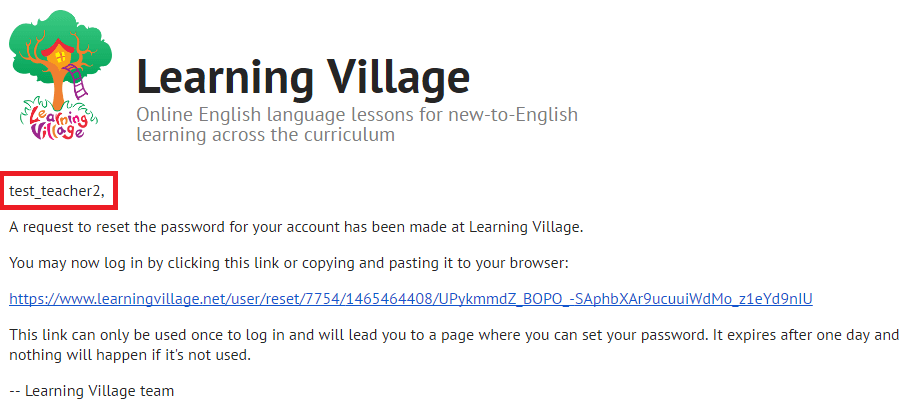
You can then click on the link to log in without a password.
Once logged in you should update your password by clicking here:
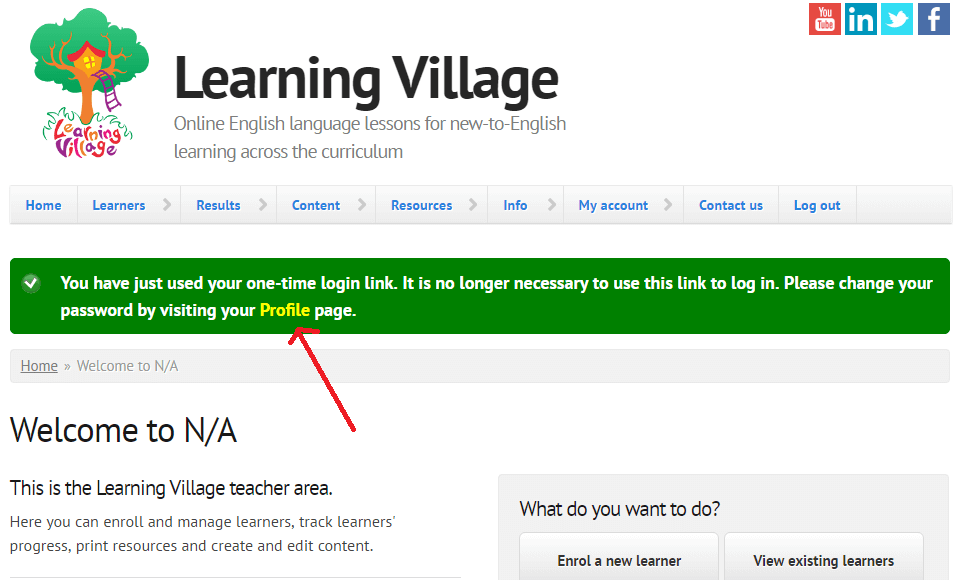
At which point you'll be taken to your profile page where you can change your password:
